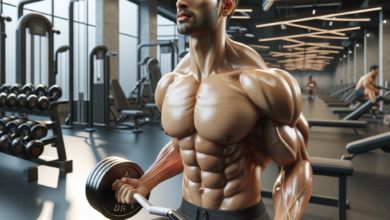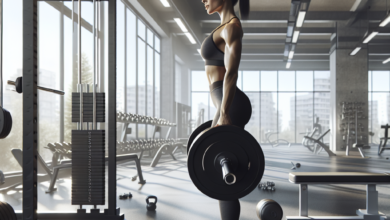9 of the Best Compound Lifts for Building Muscle and Strength

When it comes to building muscle effectively, it’s all about the compound lifts. Compound exercises offer one of the most well-rounded ways to enhance your workouts and ensure you’re getting the most out of them. Not only can compound exercises make the most out of your gym efforts, but they can also save you time!
Today, we’ll take a look at the best nine compound lifts and how you can benefit from them the next time you’re at the gym.
What Is Compound Lifting?
When you work out multiple muscles at once, this is known as compound exercising. Many strength trainers prefer this type of lifting due to its efficiency as compared to isolation exercises, which only work out one muscle group.
Benefits of Compound Lifting
The benefits of using compound lifting techniques in your workouts can be substantial. Because muscle building and strength training are all about how much and how fast you can achieve strength goals and muscle gains, working out more than one muscle group at once can be beneficial.
Aside from muscle and strength building, compound lifting can have other benefits as well:
- Flexibility – By stretching your muscles and focusing on building strength, you can potentially see gains in flexibility.
- Calorie Burning – Compound lifts have been shown to sometimes help in burning more calories during a workout due to multiple muscles being used at one time.
- Muscular Coordination – As you build strength more efficiently with compound lifting, your intramuscular coordination can increase; this can contribute to the overall amount of power and muscle you gain with each workout.
- Heart Rate Elevation – Your heart rate is directly tied to your workouts. Essentially, as your heart rate increases during workouts, it can indicate how much fat you may expect to burn during this time.

9 Compound Lifts You Can Try Next Time You’re In the Gym
- Pull-Ups – Using an overhand grip, place your hands just over shoulder-width apart and pull yourself up until the bar is chest level with you. Repeat this motion for your predetermined rep count. Pull-ups will work out your shoulders, arms, lats, biceps, and rhomboids.
- Bent-Over Row – Your lats, rhomboids, lower back, and traps get a great work out from this exercise. To perform a bent-over row, bend your knees slightly and bend your torso to an 80-degree angle. Lift your barbell just to the belly button area and then lower it back down again.
- Military Press – Military presses are great for working out your triceps, anterior deltoids, and upper pectorals. To complete this exercise, begin with a barbell you can lift to shoulder height with ease. Hold the bar with an underhanded grip at shoulder height and then lift it up and extend your arms and the barbell over your head. Lower the barbell back to shoulder position and repeat.
- Deadlift – Start with your barbell on the ground. Grip the barbell with an overhand position while bending slightly at the knees and hips. As you go to lift the barbell, allow your hips to angle further forward and straighten your torso. Complete the deadlift rep by lowering the barbell back down to the floor. This exercise works out your lower back, traps, thighs, forearms, and hamstrings.
- Dip – The dip compound exercise focuses on working out your triceps, anterior deltoids, and chest muscle groups. Using the parallel bars, grab each bar with an overhand grip, bend your elbow, and slowly lower yourself up and down. Continue the same motion for your predetermined amount of reps.
- Full Squat – Full squats work your hamstrings, adductors, quads, and glutes. Begin by standing underneath your barbell as it rests on the rack. Grip the barbell using an underhanded grip with your hands placed just over shoulder distance apart and the barbell behind you. Lift the barbell up and step forward away from the rack. Hold the barbell in place, keep your torso straight and bend your knees to be parallel to the floor. Continue this motion for your predetermined rep amount. Be sure to end your workout in the standing position so you can step back and place the barbell back on the rack.
- Bench Press – When you perform the barbell bench press, you’re working out your chest, anterior deltoids, and triceps. While lying on the bench flat, place your legs on each side of the bench with your feet flat on the floor. Grip the barbell with an overhand grip while keeping your hand’s shoulder-width apart. Lift the barbell while squeezing your shoulders and place the bar close to your chest. Extend your arms and lift up, and then bring the bar back down to your chest to complete the rep. Continue this same motion for your predetermined rep count.
- Clean and Press – To complete a clean and press exercise, you begin with your barbell on the floor. Bend your knees and get into a squatting position to grab the barbell with an overhand grip. Lift the bar in three motions; first, lift to your thigh area, then move the bar to your chin area, and then complete the movement by raising the bar over your head. The rep is complete once you’ve lowered the bar back to the ground. The clean and press exercise works out your triceps, glutes, calves, and biceps.
- Shrug – This exercise focuses on working your forearms and traps. Begin by holding a barbell using an overhand grip. While keeping your back straight, lift just your shoulders up and hold for two seconds. Lower your shoulders back down and repeat for your predetermined rep amount.

Tips to Stay Safe
While compound lifting exercises can be extremely helpful in building muscle mass quickly, it’s important to always perform them with caution and safety in mind. Keep these tips in mind to help you avoid injury:
- Spotters – Use spotters as often as possible to prevent injury from the barbell. This tip can be especially important when lifting heavier weights and when performing bench presses.
- Trainers – Whether you are trying out a new exercise or new to weight lifting in general, trainers can help ensure you are performing exercises correctly to maximize your workout and avoid injury.
- Rest – While you definitely want to place a safe amount of strain on your muscles to build them up, it’s also important to rest in between sets to allow your muscles time to repair and heal.



